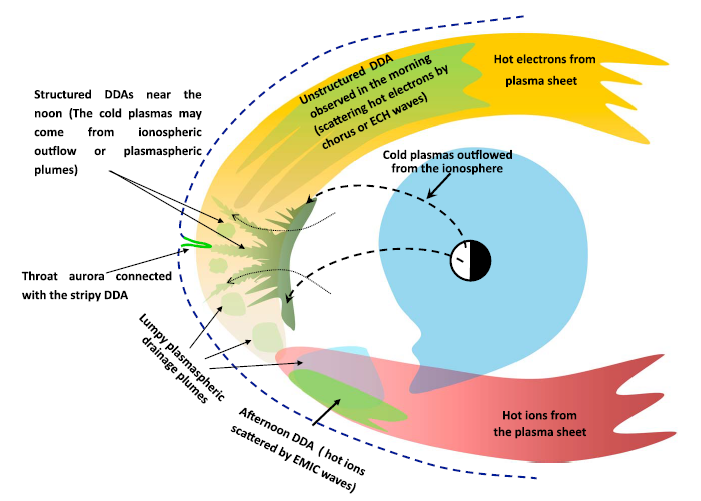A dynamic study of the ionospheric footprint of the cusp/cleft over Svalbard

Top image: Artist illustration of events on the sun changing the conditions in near-Earth space. Credit: NASA
The Earth’s cusp region is believed to be the main place of transport of the magnetosheath plasma into the ionosphere. PhD candidate Xiangcai Chen has analysed long-term ground-based optical aurora data and SuperDARN HF radar data from Svalbard to further understand the dynamics of the reconnection plasma process in the cusp region. Xiangcai will defend his PhD thesis at UNIS on 28 February.
24 February 2017
Press release from the University Centre in Svalbard (UNIS)/Birkeland Centre for Space Science and the University of Oslo (UiO)
The Earth’s cusp, as one of the most complex magnetospheric regions, has an often complex magnetic topology. Its direct relation to the reconnection plasma processes is occurring on the magnetopause and in the adjacent magnetosheath. Study on the dynamics of the ionospheric footprint of the open/closed magnetic field line boundary (OCB) in the cusp region may reveal the dynamics of the reconnection plasma process.
The OCB represents the demarcation line between the closed magnetosphere on the equatorward side, and newly opened magnetic field lines connect to the solar wind on the poleward side. The OCB on the dayside is known to respond to the interplanetary magnetic field and solar wind pressure. Both the equatorward boundary of the cusp aurora in red 630.0 nm [OI] emissions and the latitudinal transition between the high and low spectral width values from SuperDARN HF radar have been shown to be a valid proxy for the dayside OCB. However, it is still not well known how the empirical relationship between them is in response to the dynamics of the reconnection plasma process.
F region ionosphere effects on the mapping accuracy of SuperDARN HF radar echoes
Firstly, by using the wealth of ground-based data from optical instrumentations in Svalbard, Xiangcai has assessed the accuracy in ranging the OCB with the SuperDARN radar in Finland by introducing an adjusted method for simultaneously determining the ionospheric OCB using the 630.0 nm auroral equatorward boundary and the spectral width boundary from Finland radar data.
Xiangcai speculates that the enhanced ionospheric convection by transient reconnection processes can sometimes result in the intake of high-density solar extreme ultraviolet ionized plasma at sub-auroral latitudes, which could cause a stronger refraction of the HF radar ray path. This assumption is further supported by a long-term statistical analysis of the OCB differences. The asymmetric variations of the OCB differences versus magnetic local time, regardless of solar maximum or minimum conditions, always has the peak values close to magnetic local noon. The mapping accuracy of the SuperDARN HF radar echoes is thus discussed in relation to the varied ionospheric electron density at the sub-auroral latitudes due to the dynamics of the reconnection process.

Dynamic properties of the throat aurora
In order to investigate the dynamics of the reconnection process related ionospheric plasma convection in the vicinity of the OCB, Xiangcai has performed an extensive survey of the dayside diffuse auroras that relate to the magnetospheric plasma at the sub-auroral latitudes. The structured dayside diffuse auroras have statistically observed by them.
In particular, a new discrete auroral form, called throat aurora (that developed from the stripy dayside diffuse auroras), are exclusively observed near convection throat and their alignments are consistent with the direction of ionospheric plasma convection observing from the SuperDARN velocity map. In addition, a detailed case study shows that the throat aurora with poleward moving features is frequently brightening followed by dimming in auroral intensity, and the brightening is sometimes a precursor for the poleward-moving auroral forms (a typical ionospheric phenomenon of magnetopause reconnection).
The dynamic study of the throat aurora would thus reveal the magnetospheric plasma related diffuse aurora morphologies in response to the dynamics of the reconnection plasma process.

Dissertation
Xiangcai Chen will defend his PhD thesis “A study of dayside open/closed field line boundary dynamics using simultaneous ground-based optical and HF radar observations” at UNIS on Tuesday 28 February at 15:30. He will give a trial lecture entitled “Challenges in radio wave communication and navigation at auroral latitudes” at 14:30 the same day. Both lectures will take place in the auditorium Lassegrotta in Svalbard Science Centre.
Supervisors have been Professor Dag A. Lorentzen (UNIS) and Professor Jøran I. Moen (UiO). The committee consists of Professor William Bristow, Geophysics Institute, University of Alaska (1. opponent), Professor Kirsti Kauristie, Finnish Meteorological Institute (2. opponent), and Professor Arne Dahlback, Department of Physics, UiO (Leader of the committee).
About the candidate:
Xiangcai Chen (30) is from Sichuan, China. After completing his MSc degree in optics at the Inner Mongolia Normal University / Polar Research Institute of China in 2012, he started his PhD studies at UNIS / Birkeland Centre for Space Science and UiO.
Contact information:
E-mail: xiangcaichen@outlook.com
